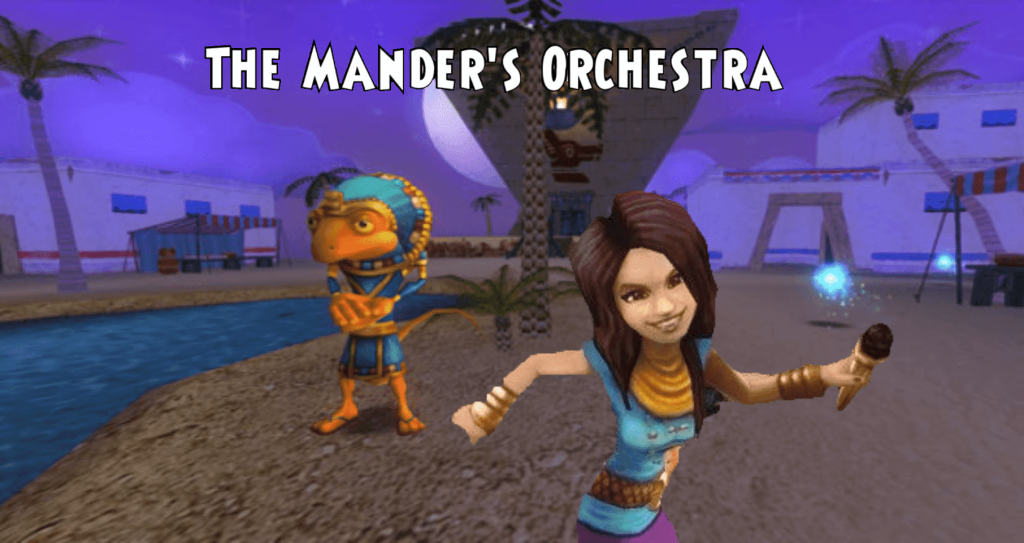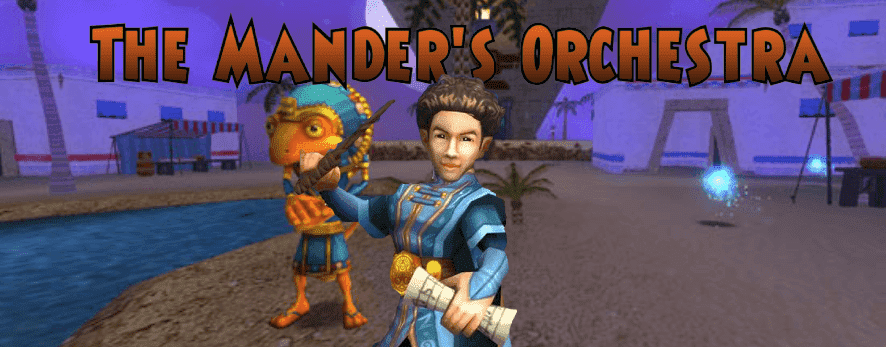
For Musician and Non-Musician Alike
Sultry, dry, and desolate, we find a great civilization that has emerged from the Oasis. Built by the Manders, composed by Nelson Everhart, and enslaved by the Kroks, a great society emerged from these sands only to wither away and be found by our Marleybonian friends.
There is continuity within music. Last time we discussed how themes develop across a story, but now we will talk about another important element of music. Atmosphere is a tool of world-building. Percussion and orchestration drive the sensation of what we hear in Krokotopia, filling the sound with specific instrumental timbres to feel the essence of where we are. We will now explore the music of Krokotopia to envision what wonders lie in store.
https://www.youtube.com/watch?v=w8FCrZtZo5k
“Main Theme 1”
First of all the music we hear of Krokotopia, the ambience is subtle but familiar. The bass in the harp instrument keeps the time after the tam-tam hit as reeds and other harps and lyres ornament the overall sound. Around 00:20 seconds in, we listen to a very familiar instrument: horns. Horns in general blend in with the instruments around them and their addition at this point is seamlessly done, simply adding onto the previously established texture by playing a simple melody of long sustained tones.
![]()
At 00:58 seconds, we have an oboe play a light melody before having the strings take over at 1:10, with the horn from before adding counterpoint to where the strings have sustained notes. What is counterpoint? In music, counterpoint is the idea that several voices should have interesting melodies at the same time. Both pitch and rhythm will differ from each other in two to four ongoing melodies. This is what people found interesting when listening to pieces such as fugues in Europe around the 1500’s to 1700’s.
I bring this up to mention the fact that music from all around the world is vastly different, and when our western ears create and develop it, the composer knows we are subject to what we are accustomed to. By combining the music we are commonly used to in video games and movies alike, as well as knowing the way to create Egyptian music, we have this magical creation.
https://www.youtube.com/watch?v=r4QR7-GAiAI
“Theme 2”
We now begin the exact same way as before, striking the tam-tam before going into the same texture. The ambience is there all the same, but now we have a very different emotion. More suspenseful, more drama – the world is becoming more elusive as we delve into the Sphinx’s clever riddle. The various instruments of the ensemble carry around ornaments until a theme is stated twice by a lyre and gets carried to the vibraphone. This theme gets repeated until we hear the melody from the previous track 00:32 seconds in, sounding doubled by the flute and horn before being carried to solo violin.
https://www.youtube.com/watch?v=wjwjBVkSbFA
“Theme 3”
Another tam-tam strike marks the start of our piece to begin the texture. This time, there is a stately upbeat pulse. The march-like pulse is a mark to go forth and continue our journey. We have a lower flute give a dreamy, dancing melody similar to some of the ostinatos from the other tracks. Ostinatos are repetitive figures that continue throughout a section or the entirety of a piece. This theme gets carried to the oboe and then the horn. The idea of the call-and-response voices is common throughout these tracks. It creates continuity to these themes and instrumental texture.
The texture of a piece builds the atmosphere and the world building of this land. The music we hear is what Krokotopia would sound like in an instrumental landscape. The march comes to a halt (no pun intended, my marching band friends) before the main theme from the previous two tracks is stated again, and always calm and airy as the first. Violins on their high E string add the slightest texture, but the impact of the texture is all the greater. It feels as though we have been met with challenge. The strings take over, brightly and crisply their strings are bowed into a beautiful glorious restatement of the main melody, with the horns strengthening the texture and chords in the meantime.
https://www.youtube.com/watch?v=zC6oakVwoYY
“Theme 4”
My personal favourite, the fourth one begins with a harp arpeggio before the loudest tam-tam crash besides the powerful horns. The mood evokes grandeur and royalty. The horns play on as flutes and harps hover their arpeggios above, like magical orbs within the royal chamber. An oboe plays the dancing melody from the previous track.
After the royal intrada, or musical introduction, the theme 3 melody hums from the flute, strings, and oboe. This serene interlude brings us to a climax with another tam-tam strike. This is one of the more exciting themes from the bunch. The strings wail the melody as percussive textures occur in the background.
We hear drums stricken with hands, clanking from what sounds like a triangle on the second beat of each measure, and a scrapping metallic sound on every offbeat. The metallic sounds from the scrapes and the triangle envision wealth. And who is the wealthiest in all of Egypt? Cleopatra of course, who would dissolve pearls in drinks only prove how rich she was. In this part of the story, we end Krokotopia by fighting Krokoptra, the Wizard101 counterpart.
At timestamp 1:09, the strings develop on the melody. Cordial and delightful, chords play behind the once solemn melody. We are coming to the end of our story in the stormy tombs of Krokotopia. Horns add flares to the music, alongside a small short-short-long motif after each phrase.
Krokotopia has not lost all of its mystery quite yet. The bright mood changes at timestamp 2:00, The entire ensemble breaks into a minor key upon the deep and dark roll of the drums. Suspended in wonder, Harps flare arpeggios into this new texture. Bells add-in, representing magic and mystery. Famous examples include Tchaikovsky’s “Dance of The Sugar Plum Fairy” from The Nutcracker Suite and John William’s “Hedwig’s Theme” from Harry Potter.
Thank you, Starlights, for venturing through my tour of The Mander’s Orchestra. Have a wonderful night.
Disclaimer:
Please note: I transcribed the music from the original/classic mode music scrolls. Not all of my transcriptions are 100% accurate, but they are close and the rhythm is properly notated. There is less sheet music in this article than the previous because there was more thematic material in the Wizard City themes.







